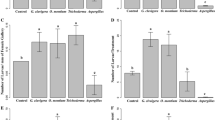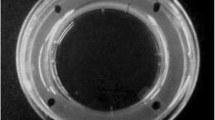Abstract
In this study, we report evidence that temperature plays a key role in determining the relative abundance of two mutualistic fungi associated with an economically and ecologically important bark beetle, Dendroctonus ponderosae. The symbiotic fungi possess different optimal temperature ranges. These differences determine which fungus is vectored by dispersing host beetles as temperatures fluctuate over a season. Grosmannia clavigera is the predominant fungus carried by dispersing beetles during cool periods but decreases in prevalence as daily maximum temperatures approach 25°C, and becomes extremely rare when temperatures reach or exceed 32°C. In contrast, Ophiostoma montium increases in prevalence as temperatures approach 25°C, and becomes the predominant symbiont dispersed when temperatures reach or exceed 32°C. The possession of different optimal growth temperatures may facilitate the stable coexistence of the two fungi by supporting growth of each fungus at different times, minimizing direct competition. Furthermore, the beetle may reduce its risk of being left aposymbiotic by exploiting not one, but two symbionts, whose combined growth optima span a wide range of environmental conditions. The possession of multiple symbionts with different temperature tolerances may allow the beetle to occupy highly variable habitats over a wide geographic range. Such temperature-driven symbiont shifts are likely to have major consequences for both the host and its symbionts under current temperature regimes and those predicted to occur because of climate change.


Similar content being viewed by others
References
Adams, AS, Six, DL (2007) Temporal variation in mycophagy and prevalence of fungi associated with developmental stages of Dendroctonus ponderosae (Coleoptera: Curculionidae). Environ Entomol (in press)
Ayres, MP, Wilkens, RT, Ruel, JJ, Lombardero, MJ,Vallery, E (2000) Nitrogen budgets of phloem-feeding bark beetles with and without symbiotic fungi. Ecology 81: 2198–2210
Barras, SJ (1972) Improved White’s solution for surface sterilization of pupae of Dendroctonus frontalis. J Econ Entomol 65: 1504
Bentz, BJ, Six, DL (2006) Ergosterol content of three fungal species associated with Dendroctonus ponderosae and D. rufipennis (Coleoptera: Curculionidae, Scolytinae). Ann Entomol Soc Am 99: 189–194
Bridges, JR (1983) Mycangial fungi of Dendroctonus frontalis (Coleoptera: Scolytidae) and their relationship to beetle population trends. Environ Entomol 12: 858–861
Carroll, AL, Taylor, SW, Regniere, J, Safranyik, L (2004) Effects of climate change on range expansion by the mountain pine beetle in British Columbia. In: Shore, TL, Brooks, JE, Stone, JE (Eds.) Mountain Pine Beetle Symposium: Challenges and Solutions, Natural Resources Canada, Canadian Forest Service, Pacific Forestry Centre, Kelowna, British Columbia, pp 223–232
Doebeli, M, Knowlton, N (1988) The evolution of interspecific mutualisms. Proc Natl Acad Sci USA 95: 8676–8680
Foster, KR, Wenseleers, T (2006) A general model for the evolution of mutualisms. Evol Biol 19: 1283–1293
Glass, NL, Donaldson, GC (1995) Development of primer sets designed for use with the PCR to amplify conserved genes from filamentous Ascomycetes. Appl Environ Microbiol 61: 1323–1330
Grylls, BT, Seifert, KA (1993) A synoptic key to species of Ophiostoma, Ceratocystis, and Ceratocystiopsis. In: Wingfield, MJ, Seifert, KA, Webber, JF (Eds.) Ceratocystis and Ophiostoma: Taxonomy, Ecology, and Pathogenicity, American Phytopathology. Society Press, St. Paul, MN, pp 261–268
Hicke, JA, Logan, JA, Powell, J, Ojima, DS (2006) Changing temperatures influence suitability for modeled mountain pine beetle (Dendroctonus ponderosae) outbreaks in the western United States. J Geophys Res III: G02019, doi:10.1029/2005JG000101
Hofstetter, RW, Cronin, JT, Klepzig, KD, Moser, JC, Ayres, MP (2006) Community interactions and the outbreak dynamics of the southern pine beetle. Oecologia (in press)
Holland, JN, DeAngelis, DL, Schultz, ST (2004) Evolutionary stability of mutualism: interspecific population regulation as an evolutionary stable strategy. Proc R Soc Lond B 271: 1807–1814
IPCC. Climate change (2001) The Scientific Basis. Contribution of the Working Group I to the Third Assessment Report of the Intergovernmental Panel on Climate Change. Cambridge University Press, Massachusetts, pp 881
Klepzig, KD, Moser, JC, Lombardero, ML, Hofstetter, RW, Ayres, MP (2001) Symbiosis and competition: Complex interactions among beetles, fungi, and mites. Symbiosis 30: 83–96
Lindgren, BS (1983) A multiple funnel trap for scolytid beetles (Coleoptera). Can Entomol 115: 299–302
Littell, RC, Milliken, GA, Stroup, WW, Wolfinger, RD (1996) SAS system for mixed models. SAS Institute, Cary, NC
Logan, JA, Bentz, BJ (1999) Model analysis of mountain pine beetle (Coleoptera: Scolytidae) seasonality. Environ Entomol 28: 924–934
Lombardero, MJ, Klepzig, KD, Moser, JC, Ayres, MP (2000) Biology, demography and community interactions of Tarsonemus (Acrina: Tarsonemidae) mites phoretic on Dendroctonus frontalis (Coleoptera: Scolytidae). Agric For Entomol 2: 193–202
Lombardero, MJ, Ayres, MP, Hofstetter, RW, Moser, JC, Klepzig, KD (2003) Strong indirect interactions of Tarsonemus mites (Acrina: Tarsonemidae) and Dendroctonus frontalis (Coleoptera: Scolytidae) Oikos 102: 243–252
O’Donnell, K, Cigelnik, E (1997) Two divergent intragenomic rDNA ITS2 types within a monophyletic lineage of the fungus Fusarium are nonorthologous. Mol Phylogenet Evol 7: 103–116
Re´gnie`re, J (1996) A generalized approach to landscape-wide seasonal forecasting with temperature-driven simulation models. Environ Entomol 25: 869–881
Robinson, RC (1962) Blue stain fungi in lodgepole pine (Pinus contorta Dougl. Var. latifolia Engelm.) infested by the mountain pine beetle (Dendroctonus monticolae Hopk.). Can J Bot 40: 609–614
Six, DL (2003) Bark beetle-fungus symbioses. In: Bourtzis, K, Miller, TA (Eds.) Insect Symbiosis. CRC Press, Boca Raton, FL, pp 99–116
Six, DL, Paine, TD (1997) Ophiostoma clavigerum is the mycangial fungus of the Jeffrey pine beetle, Dendroctonus jeffreyi. Mycologia 89: 858–866
Six, DL, Paine, TD (1998) Effects of mycangial fungi and host tree species on progeny survival and emergence of Dendroctonus ponderosae (Coleoptera: Scolytidae). Environ Entomol 27: 1393–1401
Six, DL, Paine, TD (1999) Phylogenetic comparison of ascomycete mycangial fungi and Dendroctonus bark beetles (Coleoptera: Scolytidae). Ann Entomol Soc Am 92: 159–166
Solheim, H, Krokene, P (1998) Growth and virulence of mountain pine beetle associated blue-stain fungi, Ophiostoma clavigerum and Ophiostoma montium. Can J Bot 76: 561–566
Upadhyay, HP (1981) A monograph of Ceratocystis and Ceratocystiopsis. University of Georgia Press, Athens, pp 176
Whitney, HS, Farris, SH (1970) Maxillary mycangium in the mountain pine beetle. Science 167: 54–55
Zipfel, RD, De Beer, ZW, Jacobs, K, Wingfield, BD, Wingfield, MJ (2006) Multigene phylogenies define Ceratocystiopsis and Grosmannia distinct from Ophiostoma. Stud Mycol 55: 75–97
Acknowledgements
We thank Matt Hansen, Jim Vandygriff, Aaron Adams, Kimberly Wallin, and Kathy Bleiker for their help, and Duur Aanen for sharing his insights on an earlier draft of the manuscript. This work was funded by USDA CSREES NRI (to D.L.S. and B.J.B.) and conducted as part of the W-1187 Regional Research Project.
Author information
Authors and Affiliations
Corresponding author
Rights and permissions
About this article
Cite this article
Six, D.L., Bentz, B.J. Temperature Determines Symbiont Abundance in a Multipartite Bark Beetle-fungus Ectosymbiosis. Microb Ecol 54, 112–118 (2007). https://doi.org/10.1007/s00248-006-9178-x
Received:
Revised:
Accepted:
Published:
Issue Date:
DOI: https://doi.org/10.1007/s00248-006-9178-x




